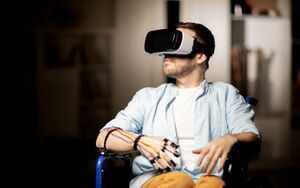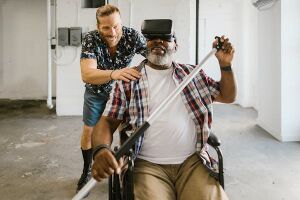VR simulations to help patients with neurological or musculoskeletal injuries
Original Editor - Syeda Bushra Zehra Zaidi
Top Contributors - Syeda Bushra Zehra Zaidi and Kim Jackson
Introduction[edit | edit source]
Virtual reality (VR) technology has been used in recent years to develop simulations that can help patients with neurological or musculoskeletal injuries recover and regain their function. By immersing patients in virtual environments that mimic real-life scenarios, VR simulations can provide an engaging and interactive therapy experience that can improve patient engagement and compliance with therapy protocols. In this article, we will discuss the ways in which VR simulations can be used to help patients with neurological or musculoskeletal injuries.
Neurological Injuries[edit | edit source]
VR simulations can be used to help patients with neurological injuries such as stroke, traumatic brain injury (TBI), or spinal cord injury (SCI). Some examples of how VR simulations can be used in neurological rehabilitation include:
Balance Training[edit | edit source]
VR simulations can be used to provide balance training exercises that mimic real-life scenarios such as walking on uneven surfaces or stepping over obstacles.
Example[edit | edit source]
One example of a balance training exercise that can be performed using virtual reality is the "weight shift" exercise. In this exercise, the patient is instructed to shift their weight in different directions to maintain balance while standing on a virtual platform. The difficulty of the exercise can be adjusted by changing the size and speed of the platform or by adding distractions such as obstacles or visual distractors.[1]
Upper Limb Rehabilitation[edit | edit source]
VR simulations can be used to provide upper limb rehabilitation exercises that mimic real-life scenarios such as reaching for objects or lifting weights.[2].
Example[edit | edit source]
One example of an upper limb exercise that can be performed using virtual reality is the "reach and grasp" exercise. In this exercise, the patient is instructed to reach for and grasp virtual objects displayed on a screen using their affected arm. The difficulty of the exercise can be adjusted by changing the size and shape of the objects, the speed of the movement, or by adding visual or auditory cues.[3]
Cognitive Rehabilitation[edit | edit source]
Cognitive rehabilitation using virtual reality (VR) is a growing field that aims to improve cognitive function and promote neuroplasticity in individuals with neurological injuries or disorders. VR simulations can provide a safe and controlled environment for cognitive rehabilitation exercises, allowing for customized and engaging interventions that are tailored to the individual's needs.
Cognitive rehabilitation using VR can include a range of exercises that target various cognitive functions, including attention, memory, executive function, and visuospatial abilities. Some examples of cognitive rehabilitation exercises using VR include:
- Attention Training: In this exercise, the patient is instructed to focus on and respond to specific visual or auditory stimuli while ignoring distractions. The difficulty of the exercise can be adjusted by changing the type and frequency of stimuli or by increasing the complexity of the task.
- Memory Training: In this exercise, the patient is asked to recall and manipulate information presented in a virtual environment. For example, they may be asked to remember a sequence of objects or navigate through a virtual maze while remembering specific locations.
- Executive Function Training: In this exercise, the patient is asked to perform a series of tasks that require planning, problem-solving, and decision-making skills. For example, they may be asked to navigate a virtual environment while avoiding obstacles or solving puzzles.
- Visuospatial Training: In this exercise, the patient is asked to perform tasks that require the manipulation and visualization of 3D objects or environments. For example, they may be asked to rotate and manipulate virtual objects to solve puzzles or complete a task.
Cognitive rehabilitation using VR can be an effective and engaging way to promote neuroplasticity and improve cognitive function in individuals with neurological injuries or disorders. However, it is important to note that VR simulations should be used as part of a comprehensive cognitive rehabilitation program that includes other evidence-based interventions.[4][5]
Musculoskeletal Injuries[edit | edit source]
VR simulations can also be used to help patients with musculoskeletal injuries such as joint injuries, fractures, or soft tissue injuries. Some examples of how VR simulations can be used in musculoskeletal rehabilitation include:
Pain Management[edit | edit source]
VR simulations can be used to distract patients from pain during rehabilitation exercises, reducing the need for pain medication especially for patients with chronic pain or those undergoing painful procedures. The immersive nature of VR simulations can help patients focus their attention on the virtual environment, reducing their perception of pain and the need for pain medication.
In VR simulations for pain distraction, patients are immersed in a virtual environment that is designed to be engaging and distracting.
One example of how VR simulations can be used for pain distraction during rehabilitation exercises is in the treatment of burn injuries. Burn patients often experience intense pain during wound care and rehabilitation exercises, which can limit their ability to perform the exercises effectively. By using VR simulations to distract patients from the pain, they can perform the exercises more comfortably and effectively, leading to better outcomes and faster recovery..[6]
Exercise Therapy[edit | edit source]
VR simulations can be used to provide a variety of exercise therapies, including balance and gait training, upper limb rehabilitation, and functional movement training. In balance and gait training, patients can use VR simulations to practice standing, walking, and other balance exercises, while receiving visual and auditory feedback to help improve their performance. In upper limb rehabilitation, patients can use VR simulations to perform exercises that target specific muscle groups, such as reaching, grasping, and manipulation tasks. In functional movement training, patients can use VR simulations to practice movements that mimic activities of daily living, such as getting up from a chair, climbing stairs, or reaching for objects.
VR simulations can be customized to suit individual patient needs and preferences, and can be adjusted to provide varying levels of difficulty to challenge and motivate patients. In addition, VR simulations can provide real-time feedback on patient performance, allowing therapists to adjust the exercise program as needed to optimize patient outcomes.
Studies have shown that VR simulations can be effective in providing exercise therapy for a range of conditions, including stroke, traumatic brain injury, Parkinson's disease, and multiple sclerosis. By providing an engaging and motivating environment for exercise therapy, VR simulations can help to improve patient outcomes and enhance overall rehabilitation.[7][8]
Conclusion[edit | edit source]
Virtual reality simulations represent a promising new tool in the rehabilitation of patients with neurological or musculoskeletal injuries. By providing an immersive and engaging therapy experience, VR simulations can improve patient engagement and compliance with therapy protocols, and ultimately improve patient outcomes. As research in this area continues to grow, it is likely that virtual reality simulations will become an increasingly important tool in the rehabilitation of a range of conditions.
Viewing in detail[edit | edit source]
References[edit | edit source]
- ↑ Mirelman A, Bonato P, Deutsch JE. Effects of training with a robot-virtual reality system compared with a robot alone on the gait of individuals after stroke. Stroke. 2009 Jun;40(6):169-74. doi: 10.1161/STROKEAHA.107.513918. PMID: 19390071.
- ↑ Laver, K. E., George, S., Thomas, S., Deutsch, J. E., & Crotty, M. (2017). Virtual reality for stroke rehabilitation. Cochrane Database Syst Rev. 2017 Nov 20;11(11):CD008349. doi:10.1002/14651858.CD008349.pub4. PMID: 29149529.
- ↑ Saposnik G, Mamdani M, Bayley M, et al. Effectiveness of Virtual Reality Exercises in STroke Rehabilitation (EVREST): Rationale, Design, and Protocol of a Pilot Randomized Clinical Trial Assessing the Wii Gaming System. Int J Stroke. 2010 Oct;5(5):47-51. doi: 10.1111/j.1747-4949.2010.00435.x. PMID: 20536993.
- ↑ Rose FD, Brooks BM, Rizzo AA. Virtual reality in brain damage rehabilitation: Review. Cyberpsychol Behav. 2005;8(3):241-262. doi:10.1089/cpb.2005.8.241
- ↑ Kim H, Kim JS, Yoon JY, et al. The Effectiveness of Virtual Reality for People with Mild Cognitive Impairment or Dementia: A Meta-Analysis. BMC Psychiatry 19, 219 (2019).
- ↑ Wiederhold BK, Gao K, Sulea C, Wiederhold MD. Virtual Reality as a Distraction Technique in Chronic Pain Patients. Cyberpsychol Behav Soc Netw. 2014;17(6):346-352. doi:10.1089/cyber.2013.0450
- ↑ Lohse KR, Hilderman CGE, Cheung KL, Tatla S, Van der Loos HFM. Virtual reality therapy for adults post-stroke: A systematic review and meta-analysis exploring virtual environments and commercial games in therapy. PLoS One. 2014;9(3):e93318. doi:10.1371/journal.pone.0093318
- ↑ Cho KH, Lee KJ, Song CH. Virtual-reality balance training with a video-game system improves dynamic balance in chronic stroke patients. J Rehabil Med. 2013;45(6):540-544. doi:10.2340/16501977-1130
- ↑ Animation & Games Development SG. Using Virtual Reality to reduce pain and aid rehabilitation. Available from: https://www.youtube.com/watch?v=Eh0WZoGflPw [last accessed 4/23/2023]








